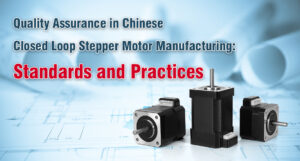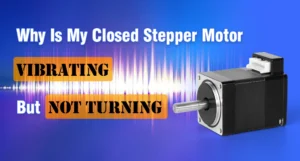Stepper motors are a staple in the world of motion control, prized for their precision and reliability. Closed loop stepper motors take these advantages a step further by incorporating feedback mechanisms that enhance performance and accuracy. In this blog, MXELECTRON delves into the intricacies of closed loop stepper motors and explores the various methods to effectively control them.
Understanding Closed Loop Stepper Motor
Unlike traditional open-loop stepper motors, closed loop stepper motors employ a feedback system that continuously monitors the motor’s position, velocity, and other relevant parameters.
This feedback enables the controller to make real-time adjustments, correcting any discrepancies between the commanded and actual motor positions. As a result, closed-loop stepper motors offer improved reliability, efficiency, and performance in applications where precise motion control is crucial.
Key Components of Closed Loop Stepper Motor Control
- Stepper Motor:
Closed loop stepper motors share the fundamental design of traditional stepper motors, consisting of a rotor and stator. The rotor moves in discrete steps in response to electrical pulses, providing precise control over its position.
- Encoder:
The crucial element that transforms a stepper motor into a closed loop system is an encoder. Encoders provide continuous feedback on the motor’s position, allowing the controller to detect any deviations from the commanded position and make necessary adjustments.
- Controller:
The controller is the brain of the closed-loop stepper motor system. It processes the feedback from the encoder and generates the appropriate control signals to drive the motor. Modern controllers often use advanced algorithms to optimize performance and reduce power consumption.

Control Methods for Closed Loop Stepper Motors
- Encoder Feedback:
One of the most common methods involves using an encoder that provides feedback on the rotor’s position to the controller.
The controller compares the actual position (feedback) with the desired position and adjusts the current supplied to the motor accordingly to minimize any position error.
- Hall Effect Sensors:
Hall effect sensors can be used to detect the magnetic field of the rotor. By monitoring changes in the magnetic field, the controller can determine the rotor’s position.
This method is commonly employed in brushless DC motors but can also be adapted for closed-loop stepper systems.
- Torque Control:
Torque control focuses on maintaining a specific level of torque output from the stepper motor.
Feedback devices measure the actual torque, and adjustments are made to the control signals to achieve the desired torque.
- Microstepping:
Microstepping is a technique that divides each full step of a stepper motor into smaller, discrete micro steps. This allows for smoother motion and finer control.
In this configuration, the drive functions in micro stepping mode, with an encoder monitoring the position of the shaft or load. When lost steps are identified by comparing the commanded position (calculated as the number of steps multiplied by the step angle) to the actual position recorded by the encoder, the controller issues additional step commands to ensure that the motor or load attains the intended position.
- Resolver Feedback:
Resolvers are devices that can determine the rotor’s angular position based on the interaction between coils and a rotating magnetic field.
Resolver feedback is less common than encoder feedback but is sometimes used in closed-loop stepper systems.
- Current Sensing:
Monitoring the current supplied to the stepper motor windings can provide information about the motor’s torque and load conditions.
The controller adjusts the current levels to ensure that the motor operates within the desired parameters.
- Sensorless Control:
Some closed loop stepper motor systems operate without explicit position feedback. Instead, they use algorithms to estimate the rotor position based on the motor’s electrical characteristics and back EMF (electromotive force).
This method is often referred to as sensorless control and can reduce costs and complexity.
Conclusion
Closed-loop stepper motors represent a significant advancement in the realm of motion control, offering improved accuracy, torque, and energy efficiency. By selecting a suitable control method, you can harness the full potential of closed-loop stepper motors for your applications.
Whether it’s in robotics, CNC machines, or other precision-oriented systems, mastering the control of closed-loop stepper motors opens doors to a new era of accuracy and reliability.






